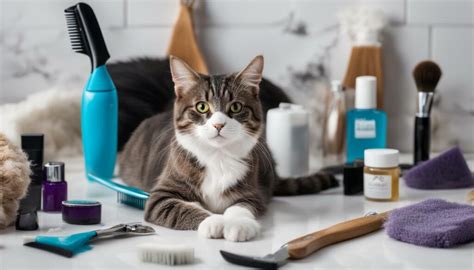Why Coat Health Matters
A healthy feline coat reflects the well-being of your furry companion. Beyond aesthetics, a well-groomed coat:

- Prevents Mats and Tangles: Regular grooming removes loose hair, preventing mats that can trap dirt and bacteria.
- Distributes Natural Oils: Grooming spreads natural oils throughout the coat, promoting shine and moisture.
- Reduces Allergens: Brushing removes dander, a common allergen, reducing symptoms for both cats and humans.
- Enhances Skin Health: Grooming stimulates blood flow, promoting healthy skin and a shiny coat.
- Strengthens the Bond: Grooming creates a special moment of bonding between you and your cat.
Step 1: Brushing Techniques for Different Coat Types
The frequency and type of brushing depend on your cat’s coat type.
Short-Haired Cats: Brush once or twice a week with a soft-bristled brush to remove loose hair and distribute oils.
Medium-Haired Cats: Brush two to four times a week with a slicker brush to remove mats and prevent tangles.
Long-Haired Cats: Brush daily with a long-tooth comb and slicker brush to prevent mats and remove large amounts of loose hair.
Step 2: Bathing and Drying
While cats are generally clean creatures, bathing may be necessary occasionally.
- Frequency: Most cats do not require frequent baths. Consult your veterinarian for specific recommendations.
- Water Temperature: Use lukewarm water (around 100°F or 38°C).
- Shampoo: Choose a cat-specific shampoo that is gentle on their skin.
- Drying: Towel dry your cat thoroughly. You can use a hairdryer on a low setting, but keep it at a safe distance.
Step 3: Preventing and Treating Common Skin Conditions
Ringworm
- Symptoms: Circular, red lesions on the skin
- Prevention: Keep your cat’s environment clean and avoid contact with infected animals.
- Treatment: Anti-fungal medication
Fleas and Ticks
- Symptoms: Itching, scratching, and skin irritation
- Prevention: Use flea and tick prevention products regularly.
- Treatment: Flea and tick shampoo, topical treatments, or oral medications
Allergies
- Symptoms: Itching, redness, and swelling of the skin
- Prevention: Identify and avoid allergens.
- Treatment: Medications (e.g., antihistamines, corticosteroids), hypoallergenic diet
Tips and Tricks
- Start grooming your kitten from an early age to accustom them to the process.
- Use treats or praise to reward your cat during grooming.
- Be gentle when brushing and avoid pulling on mats or tangles.
- Use a damp washcloth to wipe your cat’s face and ears.
- Trim your cat’s nails regularly to prevent scratching.
- Monitor your cat’s skin for signs of skin problems and consult your veterinarian if necessary.
Common Mistakes to Avoid
- Over-Brushing: Excessive brushing can damage your cat’s coat.
- Using Human Products: Human shampoos and conditioners are not suitable for cats.
- ** Bathing Too Often:** Frequent bathing can strip your cat’s coat of natural oils.
- Ignoring Skin Problems: Ignoring skin problems can lead to serious health issues.
- Not Deshedding Long-Haired Cats: Regular deshedding is essential for long-haired cats to prevent matting.
Case Detail: Matted Cat
According to a study published in the Journal of Feline Medicine and Surgery, over 40% of long-haired cats experience matting. This can be attributed to a lack of grooming or underlying medical conditions. Matted coats can be painful, unsanitary, and lead to skin infections.
Table 1: Brushing Techniques for Different Coat Types
| Coat Type | Brushing Frequency | Brush Type |
|---|---|---|
| Short-Haired | Once or twice a week | Soft-bristled brush |
| Medium-Haired | Two to four times a week | Slicker brush |
| Long-Haired | Daily | Long-tooth comb and slicker brush |
Table 2: Bathing Frequency by Coat Type
| Coat Type | Bathing Frequency |
|---|---|
| Short-Haired | Rarely (only when necessary) |
| Medium-Haired | Every few months |
| Long-Haired | Every few weeks or months |
Table 3: Signs of Common Skin Conditions
| Skin Condition | Symptoms |
|---|---|
| Ringworm | Circular, red lesions |
| Fleas and Ticks | Itching, scratching, skin irritation |
| Allergies | Itching, redness, swelling |
Table 4: Tips for Preventing Matting in Long-Haired Cats
| Tip | Description |
|---|---|
| Daily Brushing | Remove loose hair and prevent tangles. |
| Deshedding | Use a deshedding tool to remove excess undercoat. |
| Regular Bathing | Promote a healthy coat and prevent dirt accumulation. |
| Anti-Matting Spray | Apply a detangling spray to reduce the formation of knots. |





















